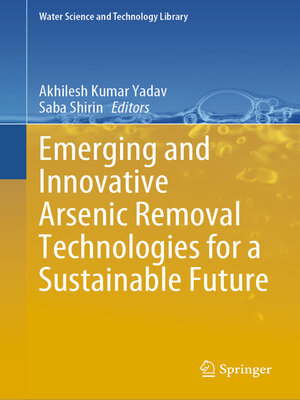Emerging and Innovative Arsenic Removal Technologies for a Sustainable Future
ebook ∣ Water Science and Technology Library
By Akhilesh Kumar Yadav

Sign up to save your library
With an OverDrive account, you can save your favorite libraries for at-a-glance information about availability. Find out more about OverDrive accounts.
Find this title in Libby, the library reading app by OverDrive.



Search for a digital library with this title
Title found at these libraries:
| Library Name | Distance |
|---|---|
| Loading... |
This book presents an overview of the techniques available today to remove arsenic contamination, pollutants, and species from water. Traditionally applied techniques for removal of arsenic pollutants/species, including oxidation, coagulation-flocculation, and membrane techniques. Furthermore, recent progress has been made on the utility of various nanoparticles for the extraction of contaminated water. Arsenic contamination affects the quality of water resources worldwide as a result of human activities (pesticides and other uses). Due to the insufficiency of water treatment facilities in developing countries, oral exposure to chemical toxicants through drinking water is a health threat. Arsenic is a mobile element with a crustal abundance of 1.8 mg kg-1 and can travel in different components of the environment, including air, soil, and water before entering into its ultimate sink, that is, bottom sediments and sea. Arsenic may enter groundwater from both geogenic and anthropogenic sources and primarily exists in inorganic form as oxy-anions. Groundwater is relatively more vulnerable to arsenic contamination from geothermal inputs, including the weathering and dissolution of arsenic-bearing rocks and minerals. Arsenic mobility is enhanced in subsurface anoxic conditions, making groundwater more vulnerable to arsenic contamination. Ingestion of groundwater-laden arsenic may cause carcinogenic and non-carcinogenic health ailments. Chronic oral exposure ≤ 50 μg L-1 of arsenic can cause skin lesions, skin cancer, melanosis, hyperkeratosis, hypertension, gangrene, cardiovascular problems, black foot disease, neuropathy, peripheral vascular disease, restrictive lung disease, bladder cancer, lung cancer etc.
Hence, specific water treatment processes are required to meet anticipated more severe water quality standards. A better understanding of currently available processes is necessary to develop economical, efficient and effective methods for arsenic removal. Arsenic can be coated, adsorbed using a wide range of mineral and organic or can be directly rejected by membrane processes such as reverse osmosis and nanofiltration. The recent development of submerged hybrid membrane systems, such as membrane bioreactors in wastewater treatment, provides alternative technologies for arsenic treatment.







